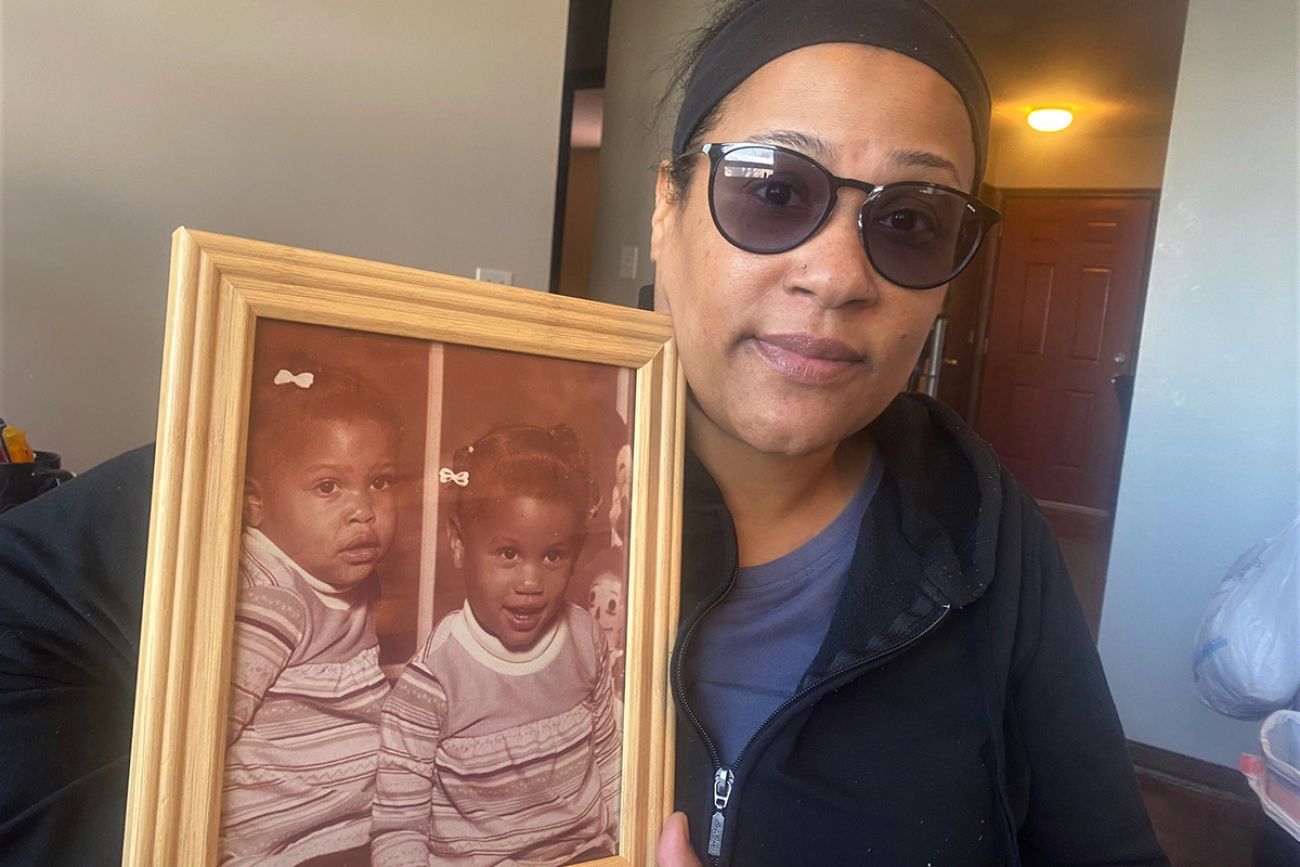‘Staggering’ rise in overdoses, suicides for African Americans in Michigan

- The opioid overdose death rate for African Americans in Michigan doubled over five years
- Suicide rates among this group climbed 88 percent over the same period
- Advocates cite lack of access to treatment, isolation and a rise in fentanyl in recreation drugs as major factors
KENTWOOD—It’s a call that suburban Grand Rapids resident Ladonna Jordan will never forget.
Her cell phone chimed not long after midnight on Nov. 16, 2019 — her birthday, one she shares with her twin sister, Donanna.
“I thought she was calling me up to wish me happy birthday,” Jordan recalled.
Instead, she was informed by a nephew that her sister had died hours earlier in Kentwood of an apparent drug overdose.
Related:
- Michigan sees spike in 988 mental health calls. But what happens next?
- Michigan takes steps to boost bed capacity for kids in mental health crisis
- Medicaid review could drop 400,000 Michigan residents from coverage
Jordan, 45, would later learn her sister died from a mix of heroin and fentanyl, the latter a potent opioid that’s been driving rising numbers of African American overdose deaths across Michigan.
Statewide, the rate of opioid overdose deaths among Black residents doubled over five years, according to Michigan’s Department of Health and Human Services. It went from 23.8 deaths per 100,000 population in 2017 to 47.6 deaths per 100,000 in 2021, the most recent year available.
But Michigan mental health advocates point to a second front that is equally troubling: A soaring rise in Black residents who died from suicide over the same period. Added together, they say, the deaths point to a treatment network that is leaving too many African Americans out in the cold.
The suicide rate among Michigan African Americians, while still lower than that for whites, climbed 88 percent over five years, from 5.8 suicides per 100,000 residents in 2017 to 10.9 suicides per 100,000 residents in 2021. White suicide was largely unchanged over the same period — 15.1 suicides per 100,000 in both 2017 and 2021.
A prominent Michigan mental health advocate called the overdose and suicide trends for African Americans “staggering.”
But Kevin Fischer, executive director of the Michigan chapter of the National Alliance on Mental Illness, said it’s common among African Americans to brush off such numbers as pain and suffering that is all too familiar. Fischer, who is African American, lost his 23-year-old son, Dominque, to suicide in 2010.
“In the general population, most people don’t realize what these disparities are. And in the African American community we have a tendency to normalize this, where it’s gotten to the point where you don’t expect the same treatment or resources as the white community. ‘Yeah, you got a drug problem, big deal,’” Fischer said.
State officials say they’re aware of the rise in suicide and overdose rates among African Americans and are working to combat it.
“We recognize the…risks among the Black and African American communities and feel grateful for our partners across the state that will help us reach these communities,” Chelsea Wuth, spokesperson for MDHHS said in a statement.
To address the rise in African American opioid deaths, Wuth said the state is working with the Michigan Health Endowment Fund, a Lansing-based philanthropic foundation, to improve access to behavioral health services for African Americans in several regions of the state.
Wuth noted that MDHHS partners with groups such as EVERYBODY-VS-STIGMA, a Detroit nonprofit that Fischer founded to combat stigma about mental health issues, especially in African American communities.
Wuth acknowledged that “currently we do not have any projects focused solely on the prevention of suicide among the Black and African American communities.”
While the precise causes of suicide are uncertain, the Michigan Suicide Prevention Commission, a state-appointed body, pointed to a constellation of factors that may be feeding the rise in suicide among Black residents.
“Black people face increased rates of risk factors, including experiences of racism, higher rates of unemployment and financial and food insecurity, disparities in other aspects of health, and limited access to care, all of which result in an increased burden of mental illness in Black communities,” it stated in a 2022 report.
Those same disparities could be expected to play a role in African American overdose deaths, as holes in the health care safety net were laid bare in the early months of the pandemic in 2020 with the onset of the COVID-19 pandemic. Michigan African Americans — 12.4 percent of the state population — comprised as many as half of the state’s COVID-19 deaths, highlighting both the lethality of the disease and consequences of racial segregation, access to health care and poverty.
In the meantime, a drug crisis that began more than two decades ago with over-prescribed opioid painkillers has morphed into a battle with the synthetic opioid fentanyl, up to 100 times more potent than heroin. Sourced primarily from China and Mexico, it’s now a culprit in most overdose deaths, mixed with heroin or cocaine or sold in fentanyl-laced fake prescription pills.
For an unsuspecting user unaware that what they’re taking contains fentanyl, a single dose can be fatal.
In Kent County in 2021, autopsies detected fentanyl in 90 percent of 84 opioid-related overdose deaths, including 100 percent of heroin overdose deaths, 88 percent of methamphetamine deaths and in 66 percent of cocaine overdose deaths.
Kent County’s opioid overdose death rate for African Americans climbed by 51 percent over four years, from 17.8 deaths per 100,000 in 2017-2019, to 26.8 deaths per 100,000 in 2019-2021. By contrast, the opioid death rate for whites fell over the same period, from 12.8 deaths per 100,000 in 2017-2019 to 11.4 deaths per 100,000 in 2019-2021.
One county overdose prevention advocate said Black drug users inclined toward cocaine may be especially vulnerable.
“In the Black community, we’re seeing more cases of cocaine in opioid-related deaths,” said Steve Alsum, executive director of the Grand Rapids Red Project, a West Michigan nonprofit agency that offers syringe exchange, HIV testing and the distribution of naloxone, a medication that can reverse an opioid overdose.
“We’re seeing cases where people were intending to use cocaine that turned out to have fentanyl in it.”
Red Project also distributes fentanyl test strips, meant to save lives by detecting the presence of fentanyl in street drugs before they are taken.
According to MDHHS, other syringe exchange programs in Michigan distributed more than 80,000 fentanyl test strips from April 2021 to December 2022.
The test strips do not indicate the amount of fentanyl in a sample — only its presence. But with fentanyl now in the vast majority of street drugs, it’s unclear how much value the strips have to deter habitual users.
A Kent County health official said the pandemic deepened the isolation of many African Americans from medical and behavioral health treatment systems, adding to their risk of overdose.
“The disparities existed before Covid. The pandemic just made them astronomically worse,” Rachel Jantz, an epidemiologist with the Kent County Health Department and member of the Kent County Opioid Task Force, a community collaborative of school, public health and hospital officials, told Bridge.
“During the pandemic, lots of people of color were trying to stay away from the medical system. And so they got further and further apart and they haven’t come back together.”
In Flint, another advocate for overdose prevention sees historic reasons for African American suspicion of the treatment network.
“The crack epidemic was never really fairly addressed in the Black community,” Teresa Springer, program director of Wellness AIDS Services, another nonprofit syringe exchange program, told Bridge, referring to the disproportionate imprisonment of African Americans for crack cocaine in the 1980s and 1990s.
“Because these things were never addressed, the mistrust built up for African Americans about the treatment community. You end up with that disparity when you leave all these populations out. It catches up.”
Springer said that alienation revealed itself when Wellness AIDS Services opened its doors in 2010. Less than 5 percent of its clients back then were Black.
“We had to reach out. It’s reaching out to communities, knowing how cultures talk and to really focus on it.”
Springer said the center’s clientele is now about one fourth Black.
Fischer of the Michigan chapter of NAMI sees other reasons African Americans fail to connect to the behavioral health treatment network: They struggle to find providers who look like them.
“Two days ago, I got a request from someone saying I’m looking for an African American psychiatrist. That’s like looking for a unicorn,” Fischer said, referring to the fact that just 2 percent of U.S. psychiatrists are black.
That could help explain racial gaps in mental health treatment that were evident even before the pandemic: 53 percent of Black U.S. adults with moderate or severe anxiety or depression in 2019 did not receive treatment, compared to 36 percent of white adults, according to KFF, a San Francisco-based nonprofit health care research organization.
But Fischer said his view is that some of the responsibility falls on those who need help.
“It may not be politically correct to say this, but in communities of color, we have to acknowledge and accept our responsibility to get better care for ourselves or our loved ones,” he said. “It’s easy to point the finger at other people and blame the government or whoever. But we have to reach out for care and to demand it.”
Over the years, Jordan, the Kentwood resident who lost her sister to an overdose, said she often felt helpless as her sister struggled with addiction issues that stretched over two decades. The sisters were separated at about age 10, as each went to foster care homes.
“Our mom had us very young,” Jordan said. “She wasn’t really prepared for motherhood.”
But as far as she knows, her sister only received treatment once, at a Florida substance use disorder treatment facility about seven years ago. She never went to a peer support group.
For most of her adulthood, Jordan said, her sister lived in and around Kentwood. She drifted from place to place, often to family members, until she wore out her welcome and moved on.
“I tried to let her know that I was there for support. I don’t know, I can’t tell you what she was thinking.”
Like many relatives of people who die from overdose, Jordan still wonders if she could have — should have — done more to prevent her twin’s death.
“It took my sister to die for me to dive in head first. How did I miss that?”
And so Jordan has channeled any guilt she may harbor to do whatever she can to spare someone else from the same fate. She volunteers at the Grand Rapids Red Project. She encourages people to get help. She now takes a dose of naloxone, the overdose antidote, wherever she goes.
“Prior to my sister dying, (I) would have been, ‘It is what it is. They smoke dope. It’s none of my business, it’s not me.’ But it kind of is your business.
“People don’t understand when other people use drugs, it’s almost like (their loved ones) use them too. They get the remnants of that, whether it’s the stealing or the lying to obtain drugs or all that comes with it.”
See what new members are saying about why they donated to Bridge Michigan:
- “In order for this information to be accurate and unbiased it must be underwritten by its readers, not by special interests.” - Larry S.
- “Not many other media sources report on the topics Bridge does.” - Susan B.
- “Your journalism is outstanding and rare these days.” - Mark S.
If you want to ensure the future of nonpartisan, nonprofit Michigan journalism, please become a member today. You, too, will be asked why you donated and maybe we'll feature your quote next time!





